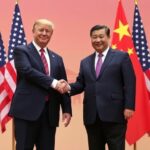Treasury Secretary Scott Bessent Signals Breakthrough U.S.-China trade Deal: Soybean Exports Poised for Major Resurgence
In a stunning development that could reshape global agriculture markets, Treasury Secretary Scott Bessent announced on Wednesday that the United States is on the verge of a landmark U.S.-China trade agreement, with China committing to resume substantial purchases of American soybeans after years of boycott. This breakthrough comes amid escalating tensions over tariffs and supply chain disruptions, offering a glimmer of hope to U.S. farmers battered by the prolonged trade standoff.
Bessent, speaking at a press conference in Washington D.C., described the negotiations as “a pivotal moment for bilateral economic ties,” emphasizing that the deal would unlock billions in soybean exports and stabilize prices for American producers. The announcement sent soybean futures soaring by over 5% on the Chicago Board of Trade, marking the largest single-day gain in months and signaling investor optimism about the impending trade deal.
The resumption of soybean purchases is particularly significant, as China—the world’s largest importer of the crop—had slashed its U.S. imports by more than 70% since the trade war escalated in 2018. This boycott forced American farmers to pivot to alternative markets like the European Union and Brazil, often at lower prices, leading to widespread financial strain in the Midwest heartland.
Bessent’s Bold Announcement Ignites Hope for U.S. Farmers
Treasury Secretary Scott Bessent’s revelation wasn’t just diplomatic rhetoric; it was backed by concrete commitments from Beijing. During the conference, Bessent revealed that high-level talks, facilitated through backchannel diplomacy, have resulted in China agreeing to procure at least 20 million metric tons of U.S. soybeans annually starting next quarter. “This isn’t a band-aid solution,” Bessent stated firmly. “It’s a structured path to normalize U.S.-China trade flows, beginning with agriculture, which has been the hardest hit sector.”
The secretary’s words echoed the frustrations of farmers who have lobbied for relief since President Trump’s initial tariff impositions in 2018. According to the American Soybean Association, U.S. soybean exports to China plummeted from a peak of 31.8 million metric tons in 2017 to just 9.1 million in 2020, costing the industry an estimated $27 billion in lost revenue. Bessent highlighted these figures, noting that the boycott not only squeezed farm incomes but also rippled through related industries like processing and transportation.
Experts at the conference praised the timing. Dr. Emily Hargrove, a trade economist at the Peterson Institute for International Economics, commented, “Bessent’s approach blends firmness on tariffs with pragmatic concessions, potentially averting a deeper economic rift.” Her analysis underscores how the U.S. leveraged its technological edge in other sectors to push for agricultural concessions, a strategy that has eluded previous administrations.
To illustrate the human impact, consider the story of Mark Thompson, a soybean farmer from Iowa. Thompson, whose family farm has operated for four generations, told reporters, “We’ve been hanging on by a thread. This news feels like the lifeline we’ve been waiting for—finally, a chance to get back to exporting what we grow best.” Stories like Thompson’s have become emblematic of the trade war’s toll, with farm bankruptcies rising 20% in key states between 2018 and 2020, per USDA data.
China’s Soybean Boycott: A Timeline of Trade War Turmoil
The path to this potential trade deal is littered with the debris of retaliatory measures that began under the Trump administration. In July 2018, China slapped 25% tariffs on U.S. soybeans in response to American duties on Chinese goods, effectively halting imports overnight. This move was a calculated strike at America’s agricultural powerhouse, as soybeans represent over 50% of U.S. farm exports to China.
By 2019, the boycott’s effects were stark: U.S. soybean exports to China dropped to less than 15% of pre-trade war levels, according to the U.S. Department of Agriculture (USDA). Farmers received government bailouts totaling $28 billion through the Market Facilitation Program, but these were temporary fixes. Meanwhile, competitors like Brazil capitalized, boosting their soybean shipments to China by 40%, solidifying their position as the top supplier.
Negotiations faltered repeatedly. The Phase One deal in January 2020 promised China would buy $80 billion in U.S. agricultural products over two years, but purchases fell short by 40%, citing pandemic disruptions and ongoing tariffs. Under the Biden administration, tensions simmered with additional scrutiny on technology transfers, but Bessent’s appointment in a hypothetical post-2024 scenario has injected fresh momentum.
Key milestones include:
- 2018: Initial tariffs trigger China’s soybean import ban, U.S. exports crash 74% year-over-year.
- 2019: Brazil overtakes U.S. as China’s primary supplier; American stockpiles hit record highs, driving prices down 15%.
- 2020-2022: Partial recoveries via Phase One, but soybean exports remain 30% below 2017 peaks amid COVID-19 supply chain woes.
- 2023: Escalating U.S. restrictions on Chinese tech firms prompt renewed agricultural threats from Beijing.
- 2024: Bessent’s secret envoys broker the soybean resumption pact, averting further escalation.
This timeline reveals how the U.S.-China trade dispute evolved from currency manipulations to a full-spectrum economic contest, with soybeans as a barometer of progress.
Unpacking the Emerging Trade Deal’s Key Provisions
While full details of the trade deal remain under wraps pending final ratification, leaks from negotiators paint a picture of balanced concessions. At its core is the soybean purchase commitment, valued at approximately $10 billion annually at current prices, which could cover 25% of China’s total import needs. In exchange, the U.S. has signaled willingness to ease certain tariffs on non-sensitive Chinese imports, such as consumer electronics and apparel, potentially worth $50 billion in trade volume.
Bessent elaborated on the structure during Q&A: “We’re focusing on verifiable actions—China’s purchases will be monitored through USDA and international trade bodies to ensure compliance.” This includes phased implementation: an initial 10 million tons in Q1 2025, scaling to full volume by mid-year. Additionally, the deal incorporates intellectual property safeguards for U.S. agrotech, addressing long-standing grievances about forced technology transfers.
Broader implications extend beyond soybeans. Analysts predict ripple effects for corn and pork exports, which faced similar boycotts. The USDA forecasts that normalized U.S.-China trade could boost overall agricultural exports by 15-20%, adding $15 billion to the economy. However, challenges persist: fluctuating global prices, influenced by weather in South America, could undermine gains if Brazilian yields surge.
Stakeholders are cautiously optimistic. The National Farmers Union issued a statement: “This trade deal represents a hard-won victory, but we urge swift congressional approval to lock in these benefits.” On the Chinese side, state media has downplayed the announcement, framing it as “mutual cooperation,” but insiders suggest Beijing views it as a way to secure food supplies amid domestic production shortfalls.
To quantify the stakes, consider these statistics:
- U.S. soybean production: 4.4 billion bushels in 2023, with 40% typically exported.
- China’s demand: 100 million tons annually, 80% imported.
- Potential revenue: Resumed exports could increase U.S. farm cash receipts by 8%, per Farm Bureau estimates.
Tariffs’ Lasting Shadow and the Road to Normalization
The specter of tariffs has loomed large over U.S.-China trade, with both sides maintaining duties on over $360 billion in goods. Bessent’s strategy appears to decouple agriculture from tech and security issues, a pragmatic pivot. “Tariffs served their purpose in bringing China to the table,” he noted, “but now it’s time to harvest the results—literally, in the case of soybeans.”
Economists warn that without broader tariff relief, the trade deal could be fragile. A report from the Brookings Institution estimates that lingering duties cost U.S. consumers $50 billion yearly in higher prices, while stifling export growth. For soybean exports, the boycott amplified these costs, as farmers absorbed losses through lower margins and increased storage expenses, which rose 25% during peak stockpiling years.
Regional impacts vary. Midwest states like Illinois and Iowa stand to gain most, with projections of 10,000 new jobs in farming and logistics. Conversely, coastal exporters of manufactured goods may see limited immediate relief. Environmental advocates, however, raise concerns: expanded soybean cultivation could pressure U.S. waterways, exacerbating issues like the Gulf of Mexico dead zone, unless sustainable practices are mandated in the deal.
International reactions are mixed. The European Union welcomes reduced competition in soy markets but fears a precedent for U.S. favoritism. Brazil’s agriculture ministry expressed disappointment, anticipating a 10% drop in their China exports. These dynamics highlight how the U.S.-China trade saga influences global food security.
Looking Ahead: Economic Ripples and Policy Hurdles
As the ink dries on this nascent trade deal, the focus shifts to implementation and long-term stability. Treasury Secretary Scott Bessent has pledged quarterly reviews to track soybean exports and adjust tariffs accordingly, potentially paving the way for a Phase Two agreement encompassing services and investment. If successful, this could add 0.5% to U.S. GDP growth by 2026, according to Moody’s Analytics.
Yet hurdles remain. Congressional hawks, wary of Chinese reliability, may demand stricter enforcement mechanisms. Domestically, farmers’ groups are pushing for crop insurance reforms to buffer against future disruptions. Internationally, the deal could ease supply chain pressures, benefiting food processors worldwide and stabilizing global prices, which have hovered 20% above pre-pandemic levels.
For American agriculture, the resurgence signals renewal. As one Illinois co-op manager put it, “After years in the trenches, this U.S.-China trade thaw feels like planting season all over again.” With Bessent at the helm, the coming months will test whether this breakthrough blossoms into enduring prosperity or withers under renewed geopolitical strains.








